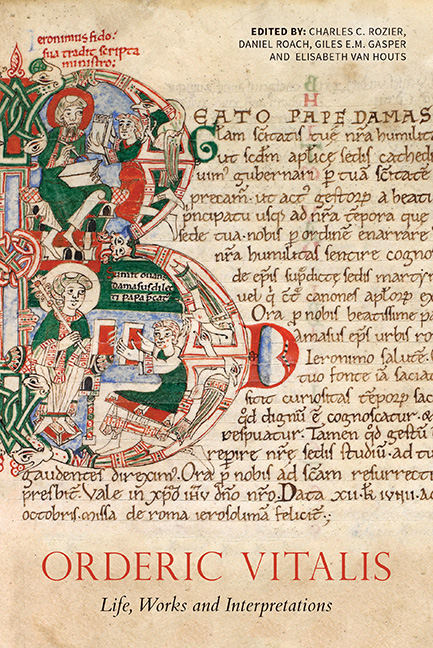Book contents
- Frontmatter
- Dedication
- Contents
- List of Illustrations
- Acknowledgements
- List of Abbreviations
- Chronology of the Lives of Odelerius and his Son Orderic Vitalis
- Composition of the Historia ecclesiastica
- Introduction: Interpreting Orderic Vitalis
- Orderic and his Father, Odelerius
- Following the Master's Lead: The Script of Orderic Vitalis and the Discovery of a New Manuscript (Rouen, BM, 540)
- Orderic Vitalis as Librarian and Cantor of Saint-Évroul
- Saint-Évroul and Southern Italy in Orderic's Historia ecclesiastica
- Orderic and English
- Inscriptions in Orderic's Historia ecclesiastica: A Writing Technique between History and Poetry
- Reading Orderic with Charters in Mind
- Orderic Vitalis and the Cult of Saints
- Orderic's Secular Rulers and Representations of Personality and Power in the Historia ecclesiastica
- Worldly Woe and Heavenly Joy: The Tone of the Historia ecclesiastica
- Orderic Vitalis, Historical Writing and a Theology of Reckoning
- Jesus Christ, a Protagonist of Anglo-Norman History? History and Theology in Orderic Vitalis's Historia ecclesiastica
- ‘Studiosi abdita investigant’: Orderic Vitalis and the Mystical Morals of History
- Meanders, Loops, and Dead Ends: Literary Form and the Common Life in Orderic's Historia ecclesiastica
- Orderic and the Tironensians
- ‘One single letter remained in excess of all his sins …’: Orderic Vitalis and Cultural Memory
- The Reception of Orderic Vitalis in the Later Middle Ages
- Appendix 1 Archaeological Investigations at the Abbey of Saint-Évroult-Notre-Dame-des-Bois
- Appendix 2 Descriptive Catalogue of Manuscripts Featuring the Hand of Orderic Vitalis
- Select Bibliography
- List of Manuscripts Cited
- General Index
Reading Orderic with Charters in Mind
Published online by Cambridge University Press: 25 October 2017
- Frontmatter
- Dedication
- Contents
- List of Illustrations
- Acknowledgements
- List of Abbreviations
- Chronology of the Lives of Odelerius and his Son Orderic Vitalis
- Composition of the Historia ecclesiastica
- Introduction: Interpreting Orderic Vitalis
- Orderic and his Father, Odelerius
- Following the Master's Lead: The Script of Orderic Vitalis and the Discovery of a New Manuscript (Rouen, BM, 540)
- Orderic Vitalis as Librarian and Cantor of Saint-Évroul
- Saint-Évroul and Southern Italy in Orderic's Historia ecclesiastica
- Orderic and English
- Inscriptions in Orderic's Historia ecclesiastica: A Writing Technique between History and Poetry
- Reading Orderic with Charters in Mind
- Orderic Vitalis and the Cult of Saints
- Orderic's Secular Rulers and Representations of Personality and Power in the Historia ecclesiastica
- Worldly Woe and Heavenly Joy: The Tone of the Historia ecclesiastica
- Orderic Vitalis, Historical Writing and a Theology of Reckoning
- Jesus Christ, a Protagonist of Anglo-Norman History? History and Theology in Orderic Vitalis's Historia ecclesiastica
- ‘Studiosi abdita investigant’: Orderic Vitalis and the Mystical Morals of History
- Meanders, Loops, and Dead Ends: Literary Form and the Common Life in Orderic's Historia ecclesiastica
- Orderic and the Tironensians
- ‘One single letter remained in excess of all his sins …’: Orderic Vitalis and Cultural Memory
- The Reception of Orderic Vitalis in the Later Middle Ages
- Appendix 1 Archaeological Investigations at the Abbey of Saint-Évroult-Notre-Dame-des-Bois
- Appendix 2 Descriptive Catalogue of Manuscripts Featuring the Hand of Orderic Vitalis
- Select Bibliography
- List of Manuscripts Cited
- General Index
Summary
Drops of holy water on an altar, whereupon a nobleman laid down his gift …
A small detail, set in a few words, but specific enough to turn the description of a gift by William of Breteuil, on the very day of the abbatial church's dedication, into a narrative that escapes the usual dryness of a diplomatic text – and to support, to the historian's eye, not only the credibility, but also the value that Orderic Vitalis added to this kind of source. Indeed, as his editors, whether Auguste Le Prevost assisted by Léopold Delisle, or the late Marjorie Chibnall, have pointed out, Orderic made frequent use in the Historia ecclesiastica of diplomatic sources, often when reporting either the story behind the refoundation of SaintÉvroul (in Book III) or its acquisitions (mainly in Book V). This has strengthened the idea, expressed casually by some historians, that there is little distance between Orderic and themselves, that he is one of us, a medievalist, because he used sources, and among them records and charters, as ‘real’ historians do. The fact that Orderic is known to have included in his narrative stories told by witnesses, often old monks at Saint-Évroul, or scenes he himself witnessed, means that he is usually regarded as a good informant regarding subjects such as noble mentality, feuding, and the sense of the supernatural, and also, in all likelihood, on literacy.
‘Reading Orderic with charters in mind’ could simply mean that the historian tracks down all Orderic's references to diplomatic texts within the pages of the Historia, first of all to consider how he used them as sources for his own work, and second to gather facts on his contemporaries’ uses of the written word – in our case of charters, what might be termed their diplomatic literacy. The first trail has already been followed by Chibnall in the introductions to her magisterial edition of the Historia, both the general introduction and those of specific volumes (especially volumes II and III). While the second aspect of the task has not yet been conducted systematically, the Historia has already been used as a seam of examples mined by historians of monastic culture.
- Type
- Chapter
- Information
- Orderic Vitalis: Life, Works and Interpretations , pp. 145 - 171Publisher: Boydell & BrewerPrint publication year: 2016



